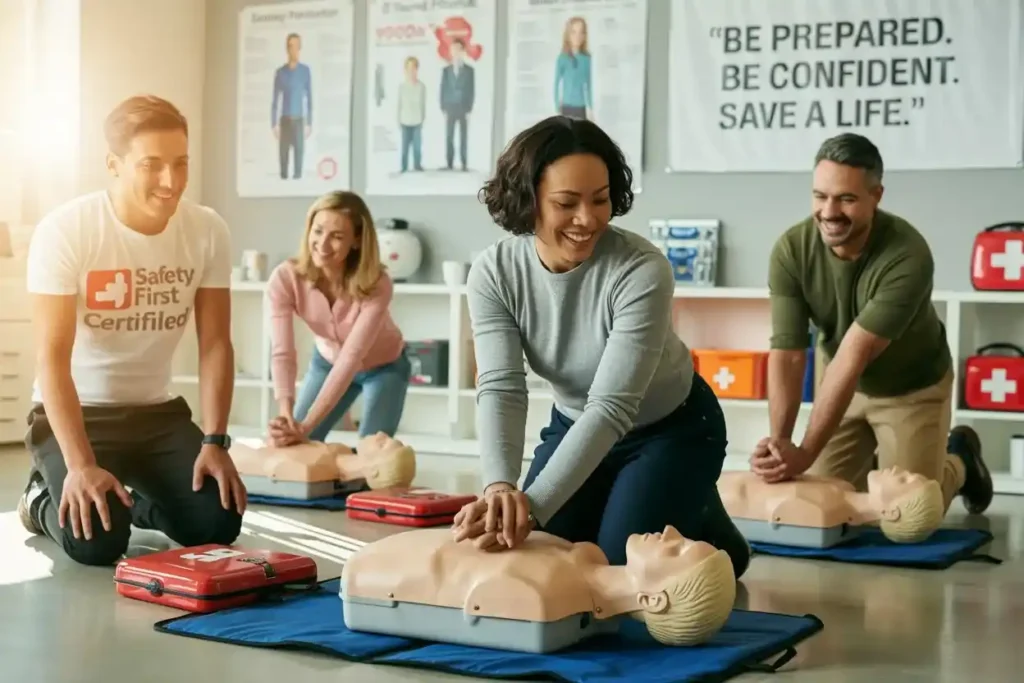Disasters are never far away at work, at home, or in the streets. It might be somebody choking during dinner, falling on the pitch, or slipping downstairs. At that moment, what you do can actually help?
A first aid course gives you the practical skills and confidence to help at the moment that really matters. You do not need to be a medic, nurse, or teacher. First aid is easily learnt by anyone. And should be learnt.
This guide sets out what is taught on a first aid course, the types of training available in the UK, and why it is one of the most useful skills to have whoever you are or whatever your job.
What Is a First Aid Course?

First aid training teaches you what to do in case of accidents, injuries and sudden illness until the emergency services arrive. It’s about knowing how to act when a person is injured, ill or unconscious and doing it safely and as quickly as possible.
You will learn to:
- Check a person’s airway, breathing and circulation
- Perform CPR (cardiopulmonary resuscitation)
- Use a defibrillator (AED)
- Deal with bleeding, burn wounds and dress wounds
- Identify stroke, heart attack or shock
- Assist a person who’s choking or having a seizure
These are for total beginners and refresher skills brought along. They are likely to involve simulation practice with CPR manikins, bandages, and authentic scenarios so that you have the ability to rehearse in a secure manner.
Also read: First Mortgage Aids in the Development of Your Financial Future
Why Do a First Aid Course?
- You Might Save a Life:
Early CPR or bleeding control can significantly raise the rate of survival before paramedics arrive. - You’ll Remain Calm Under Pressure:
Training shows you how to respond calmly instead of panicking even under pressure. - You will Act Confidently:
Having a role to play gives you the confidence to take action first when everyone else is unsure what to do. - It Saves the Workplace:
Employers need trained personnel to meet their legal obligations and make work safer for everyone. - It’s Handy Anywhere:
Whether parent, tradesperson, coach or carer first aid is something that travels with you.
Types of First Aid Training in the UK:
There is training for everyone, whether it’s for work, family, or self-improvement. Most training is offered by organizations like the British Red Cross, St John Ambulance, or HSE-approved training centers.
Emergency First Aid at Work (EFAW):
1 day
Ideal for: Low-risk workplaces like offices and retail
Includes: Bleeding, burns, defibrillators, CPR, and general medical emergencies
Also read: Health Management Services and Technology
First Aid at Work (FAW):
3 days
Ideal for: Manufacturing, construction, or high-hazard workplaces
Includes: EFAW topics plus fracture, spinal, and detailed incident management
Paediatric First Aid:
Duration: 2 days
Ideal for: Parents, childminders, nursery nurses
Includes: Child and infant emergencies
Basic Life Support (BLS) & AED:
Duration: 2–4 hours
Ideal for: Anyone who wants detailed training in cardiac arrest
Includes: Defibrillation, CPR, and aiding an unconscious person
Mental Health First Aid:
Length: 1–2 days
Ideal for: Managers, teachers, support staff
Includes: How to care for someone in emotional crisis or distress
What You will See on a First Aid Course?
If you have not done one before, don’t worry courses are straightforward and open to everyone. You do not need any experience of working in the health service.
You will normally:
- Train in small groups
- Practice giving CPR on yourself
- Learn how to apply dressings, slings and bandages
- Act out emergency scenarios in role-play
- Ask questions at your own rate
- Receive a valid certificate for up to three years
- Trainers are friendly, professional, and used to teaching people with no prior experience.
Who Should Take a First Aid Course?
Brief answer: everyone.
But especially:
- Employers and team leaders — to meet health and safety needs
- Parents and carers — to manage emergencies at home
- Teachers and childcare workers — to care for children safely
- Construction workers and tradespeople — where there is greater risk
- Sports coaches and gym staff — in case of injury or collapse
- Community volunteers — where support may be needed on the spot
- Carers for elderly or vulnerable adults — who may face sudden illness
- Even if you are not required to have first aid training, it’s a smart, responsible choice.
Cost and Accessibility:
Prices depend on course and supplier:
- Workplace training: £100–£300 per participant
- Standard public courses: Often cheaper or even free through charities or the local council
- Group bookings: Often discounted for employers or community groups
If you are not sure what course to do, most suppliers will help advise you depending on your occupation, age range, and responsibilities.
Final Thoughts:
A first aid course is one of the simplest, most practical ways to help others and protect yourself. It takes just a few hours. It does not require special knowledge. And it can save lives.
Whether it’s a child choking, a colleague collapsing, or a stranger in distress, you will know how to step in and make a difference. That peace of mind is worth more than any certificate but you will get that too.
If you have never trained in your life, now’s the time. If you trained a few years back, get a refresher. Because if something happens to go horribly wrong, the guy next to you is the one who’s going to need help. And with some training, you can be the one to help.

